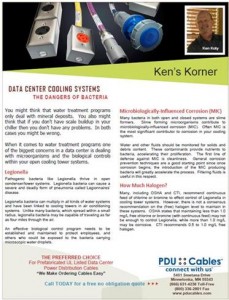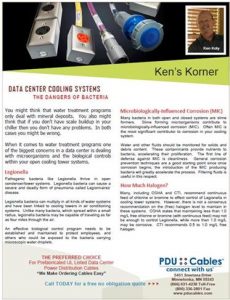KEN'S KORNER - Dangers of Bacteria 2
The Dangers of Bacteria in a Data Centers Cooling System – Part 2.
Data Center Cooling Systems - Dangers of Bacteria
In the first part of our discussion on bacteria in a data centers cooling system, we covered the health risk dangers of Legionella bacteria, the corrosive nature of slime forming microorganisms that contribute to microbiologically influenced corrosion (MIC), and the effect of free floating organic masses in your cooling systems. Along with these dangers we outlined 10 guidelines for dealing with this bacterial threat.
In this installment we’d like to discuss filtration, an often overlooked biological control tool for managing data center cooling system and this is especially beneficial in Thermal Energy Storage (TES) Chillers, and chilled loop systems.
It doesn’t really make any difference which type of filtration you choose; bag, cartridge, sand/media, filtration removes what bacteria needs, food and suspended solids, to grow and survive. Like dealing with all pests, without food and a place to hide, controlling microorganisms is much easier.
Removing Food & Suspended Solids from Cooling Systems
• Sand/media filters are the top choice in loop system filtration. These automatic backwash filter systems provide continuous hands free protection. Bags or large cartridge filters work in conjunction with sand filters and will remove suspended solids down to 1.0 micron.
• Boosting the flow rate in TES/Chiller water tanks will keep sediments moving preventing them from settling, aiding the filtration systems in removing solids.
• Use Chlorine dioxide to biologically treat water chemistry. Chlorine dioxide is the most effective micro-biocide available today and acts as both an oxidizer and a poison to microorganisms. Chlorine dioxide has the ability to invade biofilm and penetrate sediment to go after hiding bacteria.
One final suggestion in managing your data center cooling system; actively monitor biological activity. Bacteria tests are easy and effective to use.
Knowing that biological activity is being actively monitored and managed will help you to sleep more easily at night. You and senior management will both appreciate knowing that your cooling system doesn’t represent a health risk or a possible system failure to your data center.
Ken Koty
P.S. I’d like to thank Steve Blumke and our friends at Fremont Industries for helping create this article on the dangers of bacteria in a data centers cooling system.
For a link to Fremont Industries website


